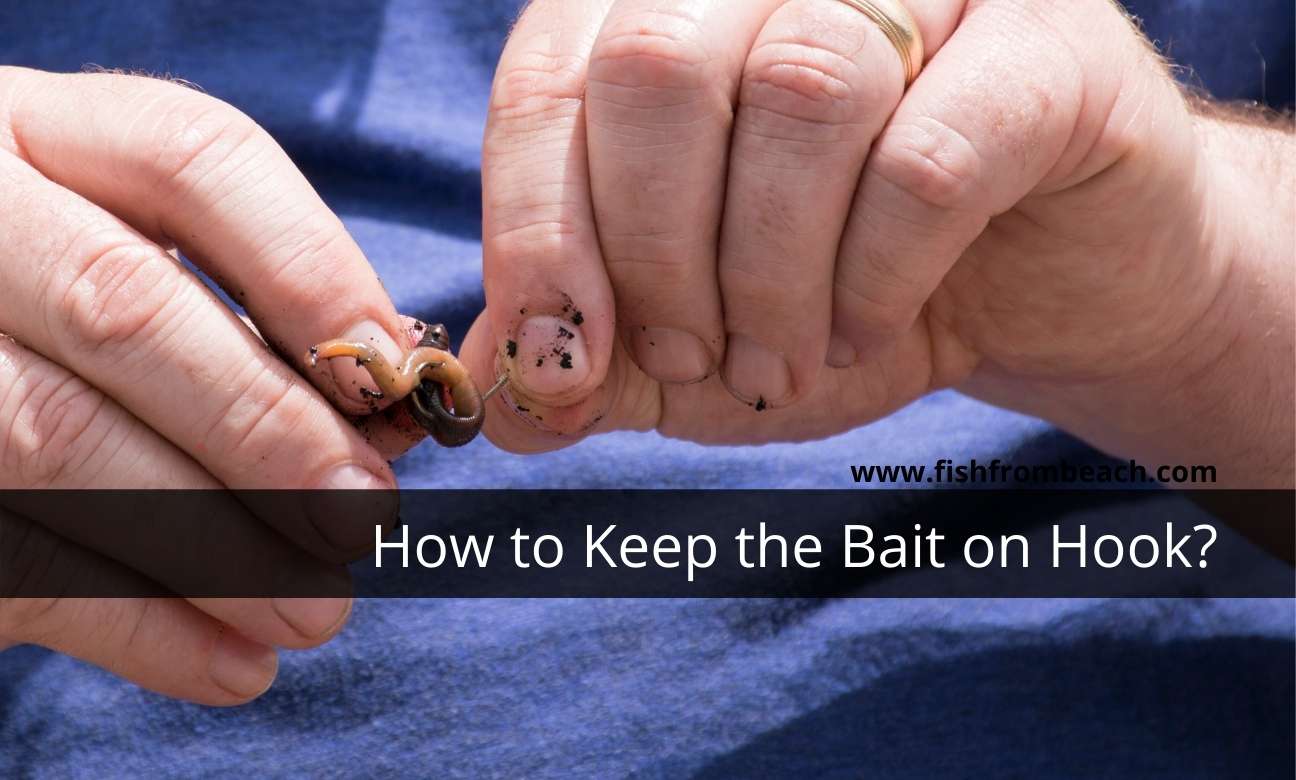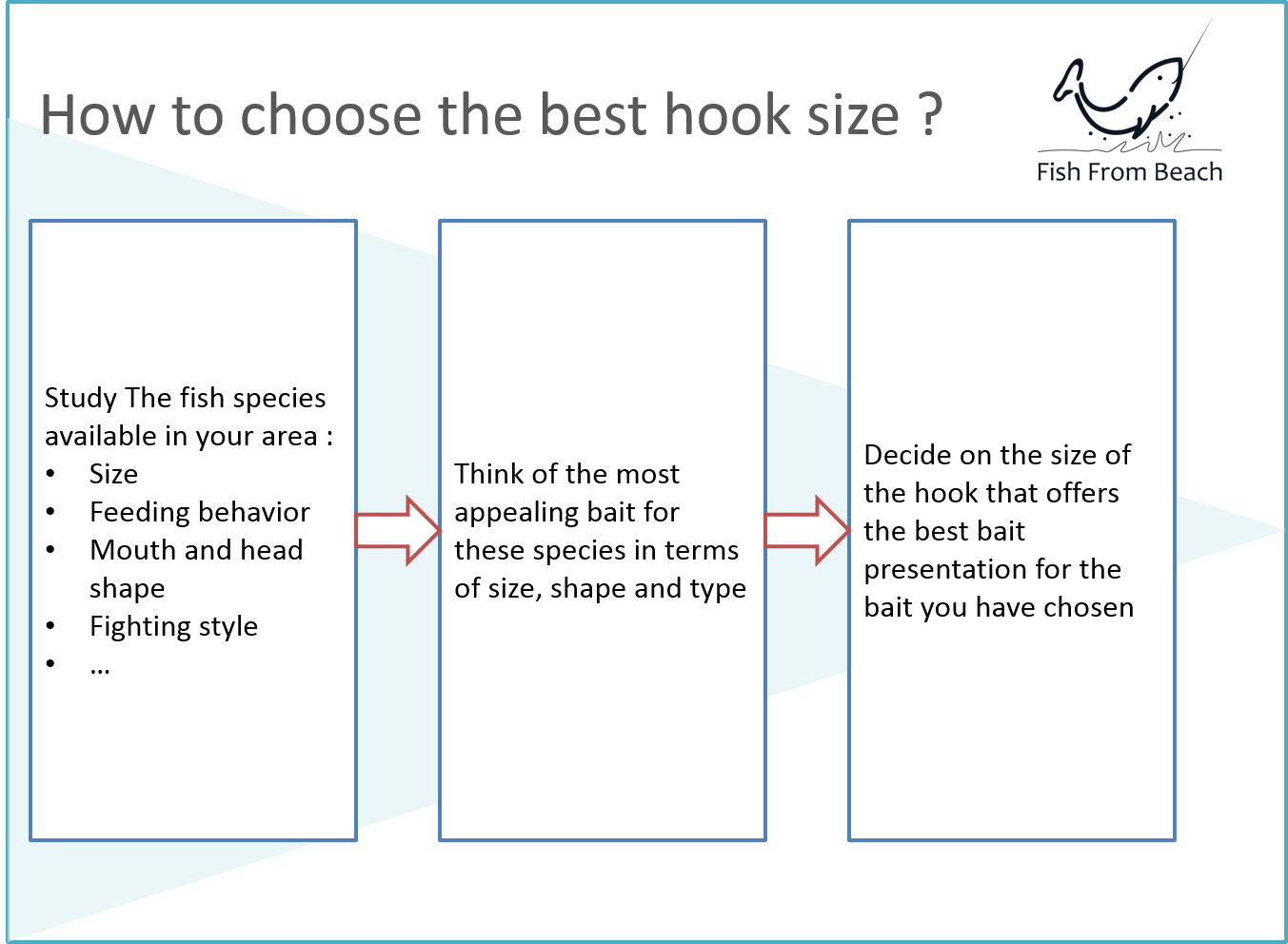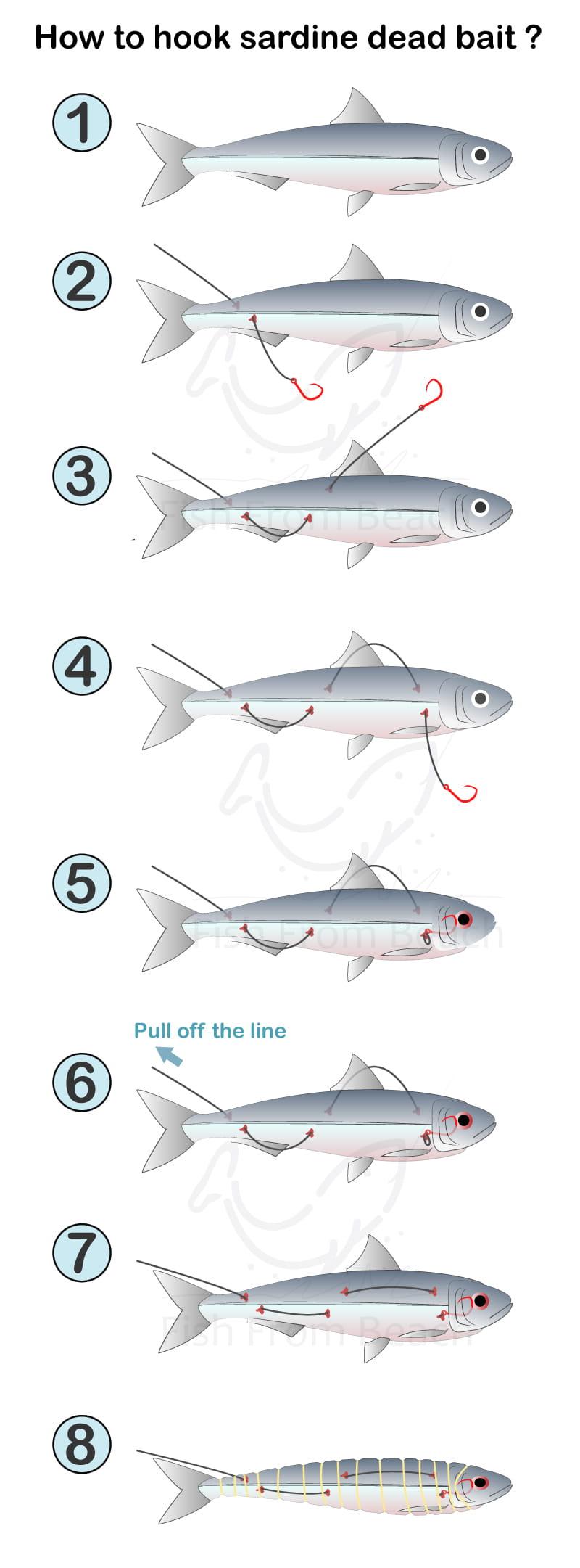
It’s a genuine struggle to keep baits on hook when surf fishing.
The need for long casts to reach the breakers puts the baits under massive stress during the load, making them more likely to fly off before reaching the water.
What’s worse is that when you’re standing on the shore tens of yards away, it’s pretty hard to tell if your bait is still on the hook or it has fallen somewhere else during the cast.
This uncertainty can give you a hard time deciding whether to wait for a bite when the hook may already be empty, or to pick up the line and find out that the bait is actually still there.
Even when you are sure that the bait has made it to the water, the impact of the splash down, if it does not tear the bait off the hook, can at least cause it to collapse and make it less appetizing for the fish.
It is therefore very important to have a good approach when baiting your hooks. The goal is to be 100% sure that no matter how powerful your casts are and no matter how the bait drops into the water, it will stay on the hook, stable, good-looking, and attractive to fish.
That’s what I decided to write about today.
In this article, we will learn 9 working tips on how to keep your baits on hook when surf fishing.
1- Watch the size of your hook
Using the wrong hook size is the number #1 reason baits fly off after casts.
There is a common misconception in the fishing world that the size of the hook depends on the targeted species, and that the larger the fish you chase, the larger the hook should be.
This is totally wrong.
Your hook size should be dictated by the size and shape of your baits, not the fish you want to catch.
Think of it this way: when the hook is too small for the bait, most of the flesh goes unhooked and far from the hook’s wire. Obviously, this reduces the balance of the bait and as a result makes it more prone to falling or crumbling after the cast.
But when the bait is tightly pierced and there are no parts that are far from the hook, it becomes very difficult to separate the two and the bait has a great chance of remaining intact during the whole cast.
Yes, it’s a good thing to match your baits to the targeted species. After all, you cannot use pompano-size baits when only pompano-size fish are around.
But after choosing your bait and you are about to decide the size of your hook, forget totally about the fish you chase and focus only on the bait.

Ok, but how to match the hook to the bait?
Well, the rule is quite simple: your hook has to ensure a good bait presentation. And by good bait presentation I mean 3 simple things:
- The bait is appealing and appetizing to the fish
- The bait is tightly holding on the hook and does not crumble easily
- Fish cannot steal the bait without getting caught
Satisfy these 3 conditions and you will have an easy time keeping baits on hook when surf fishing.
As a bonus, the following tables summarize the average hook size per fish species and per bait type.
The figures below are the result of an extensive consolidation of what fishermen say they use, both on the real world and online forums.
Hook size per fish species
| Fish Species | Hook Size |
|---|---|
| Whiting | #2 - 1/0 |
| Spanish Mackerel | 2/0 - 3/0 |
| Flounder | 2/0 – 3/0 |
| Bream | #4 - #1 |
| Porgy | #4 - #1 |
| Surfperch | #4 - #2 |
| Sea trout | 1/0 - 2/0 |
| Pompano | #1 - 2/0 |
| Blackfish | 2/0 - 3/0 |
| Redfish | 8/0 - 10/0 |
| Bluefish | 3/0 - 5/0 |
| Stripped bass | 7/0 - 9/0 |
| Tarpon | 4/0 - 8/0 |
| Red snapper | 5/0 - 7/0 |
| Codfish | 4/0 - 6/0 |
| Sharks | 7/0 - 10/0 |
Hook size per bait type
| Bait Type | Hook Size |
|---|---|
| Nightcrawlers | 1/0 - 5/0 |
| Waxworms | #4 - #1 |
| Lugworms | 1/0 - 4/0 |
| Minnows | #2 - 2/0 |
| Squid | 2/0 - 4/0 |
| Shrimp | 1/0 - 3/0 |
| Crabs | #1 - 4/0 |
| Shellfish | #1 - 4/0 |
| Herring | 1/0 - 6/0 |
| Pilchard | 1/0 - 6/0 |
| Mackerel | 1/0 - 6/0 |
2- Watch the type of your hook
The size is not the only thing to consider about your hooks. The type and shape play an important role too.
The first and most important thing to remember here is to never use a barbless hook. In other words, make sure that the hook you want to use has a small barb pointing in the opposite direction of the point.
The purpose behind barbs is to make it hard for fish to free their mouth after being hooked up, but they also prevent baits from receding under pressure.
So never forget that. Barbless hooks will just make it hard for your baits to stay on the line.
Besides the barb, hooks with longer shanks tend to hold baits better.
This is because the longer the shank, the more space you have to put the bait on a balanced position.
Long shanks also offer the possibility to try different methods of baiting and see which one holds baits best.
As for the type, I believe that bait holder hooks have the best bait-retention properties.
These hooks have generally long shanks which helps to put the bait on a wider space and therefore keep it balanced and less likely to fall.
In addition, bait holder hooks are equipped with extra barbs (typically 2) on the shank, which helps to secure the baits and gives them extra resistance against water and wind.
Circle hooks are also a good way to go if you struggle to keep your baits on the hook when surf fishing.
With their point heading back to the shank, circle hooks help trap baits inside the gap and therefore make them more resistant to high-intensity casts.
On top of that, circle hooks are really good for surf fishing and offer a bunch of advantages on the shore.
3- Choose firmer baits
If you want your baits to stay longer on the hook, then pick the ones that are firm and do not crumble easily under pressure.
Crabs are my favorite here. When I use them for bait, I have a hard time piercing them to the point of being sure that the hook won’t back out no matter what.
Fresh sardines (or pilchard) holds well too.
Like I said, the way to decide here is to see whether the bait can be pierced easily or not.
If you feel some resistance and it is difficult to break through the flesh, then it’s a good bait and will last a long time.
If, on the contrary, the bait starts to collapse or tear while it is still in the baiting phase, better not to use it. Chances are that it will not make it past the cast and will fly away before reaching the waves.
That’s why I prefer squid over shrimp. Shrimp is just hard to stabilize on a hook. You have to be extremely careful with it just to make it cast-ready.
Squid on the other hand is toughter and you can feel some resistance when working it. The same way goes with snails, bivalves, and oyster.
These crustaceans make you feel that there is a backbone in there and therefore a good feeling of what may happen after the cast.
Worth noting that the fresher your bait, the better. Old or frozen bait tend to have a softer flesh, which makes it more likely to tear off the hook under stress.
4- Hook the firmer parts
Choosing a firm bait is not enough. You still have to go the extra mile and find a firm spot through which to pierce it.
I can only give general guidance here because it all depends on which bait you want to use.
After all, this is a skill that you can only master after a lot of trial and error and after familiarizing well with your baits.
For baitfish, for example, the vertebrae spin is known to be the firmest zone.
This is generally the best way to go when using minnows and the other small baitfish species.
Try it and you will see that getting your hook through the backbone will give you a hard (and reassuring) time.
For larger species, the tail section tends to be the better part. That’s what I use with sardine dead bait. I simply cut the lower part of the fish, pierce it with a good size hook, and cast into the surf.

The eyes contour also proves to be a firm zone in fish.
Now compared to baitfish, squid and octopus are generally more homogeneous.
This means that there isn’t really a spot firmer or softer than the other and you should be okay wherever you insert the hook. Just make sure the bait is well in balance and then cast it into the surf.
For crabs, I hook them from the shoulders just under the shell. No problem here. As I said, crabs hold hooks well.
5- Use an elastic thread
If there isn’t a spool of elastic thread in your tackle box, go buy one right now.
This is a critical item to have if you are serious about keeping your baits on hook when surf fishing.
Some call it the magic thread, and it really does magic work keeping baits intact, even with very powerful casts.
How does it work? Very simple. After you finish hooking your bait, turn the thread 10 to 15 times around the bait, and… that’s all.
No need to tie or make any knot. Just wrap the thread multiple times and you should be ready to go.
Make sure you don’t squeeze too hard so you don’t mess things up, especially with soft baits like shrimp and baitfish.
Also, try to cover the entire bait with the thread to give it better balance on the hook.
What I like the most about the elastic thread is that it doesn’t only secure baits on the hook, but also conserves their scent and appetizing look.
This is because the thread is very thin and no matter how many times you wrap it around the bait, it keeps looking good and appealing.
Moreover, the thread maximizes your chances of catching large fish because it makes it difficult for the small species and sand crawlers to break your bait into small chunks and therefore make it unattractive for the sizeable guys.
6- Add salt to your baits
Salt makes baits firmer and therefore more durable on hooks.
So if you can get your bait one day before you head to the beach for fishing, put it in a large bowl and cover it with an extensive amount of salt (8-10 oz).
If your bait is filling the bowl, use another bowl or break the bait quantity into multiple layers and put salt between the layers too.
No need to get fancy here. Just a regular table salt will do the trick.
Now put the bowl in the fridge and leave it there for the entire night.
To be honest, I have only used this method with baitfish. I’m not sure if it’s effective with the other baits too. But I have read about other surf anglers doing the same thing with worms and shrimp. So I believe it should work no matter what you want to use.
7- Sew through your bait
Sewing with the hook and line is an easy, yet very effective way to conserve your baits when surf fishing.
I often use this method when baiting with whole or halved baitfish, as well as with fillets, squid, and octopus.
The process is quite simple. Tie your hook to a good size line, then use it to make 2-3 holes in the bait, side to side.
After you finish this bloody sewing process, pull off the line and make it tight and straight. That’s all. The line going through the bait will help to keep it on the hook for a long time.
If you want to add an extra layer of certainty, use an elastic thread and bind the bait more closely to the hook. Make as many wraps as you want, but don’t cover the hook. You want the hook’s point to remain visible and able to catch things.
The pictures below summarize the entire process when using sardine as bait.

8- Hook through worms
Worms, if used right, can hold pretty well on hooks.
The best way to hook worms and ensure good retention is what I call the end-to-end method.
In simple words, the end-to-end method means threading an entire worm into a hook.
Let me tell you how.
Take a live worm, preferably a long bloodworm, nightcrawler, or lugworm, pierce it from the mouth or just under the head, and start sliding it up through the curve of the hook.
Keep pushing and threading the worm until the head reaches the hook’s eye or even the line.
Once you see that the hook is completely hidden inside the worm, pierce the other end of the worm and let the barb of the hook come out so the worm cannot slide back when you cast.
Also, it’s recommended to leave a small part of the worm unhooked so that it can hang freely and move a little bit in the water. This gives it a more natural look and should improve your hookup.
To be honest, the end-to-end method is not a straightforward thing, especially for novice anglers with no experience with worms.
So expect to lose and tear a lot of bait while learning this.
If you want to make things easier, consider buying a worm threader. It makes it much easier to slide worms along hooks.
Read our complete guide to surf fishing with worms for more details.
9- Maybe you don’t need to cast that far
The more energy and power you put into the load, the more stress you exert on the bait, and therefore, the greater the risk of losing it after the cast.
When it comes to surf fishing, the amount of fish you catch does not correlate with your casting distance.
In fact, the spots closest to the shore are sometimes the most rewarding.
So unless there is a screaming reason to cast halfway across the ocean, try to mix up your targeted spots and check different areas in the surf.
Look for covered zones, cut-offs, points, rip currents, and sandbars that you can reach with an easy cast without risking your baits.
Read this article where we discussed the spots to look for when surf fishing.
Some recommended bait-related gear (*)
Note (*): If you make a purchase through links from this website, we may get a small share of the sale from Amazon or other similar affiliate programs.
Surf Fishing Survey
Help us provide you with better content by answering simple questions about your surf fishing experience and knowledge.
We will put the collected responses together and turn them into valuable information that will help you catch more fish from shore 😉
Note: No personal information will be collected with your answer.

